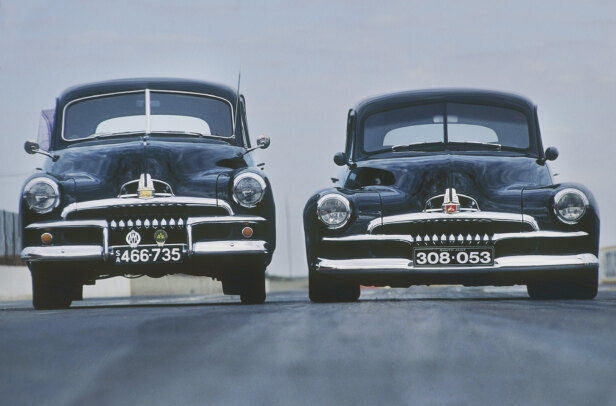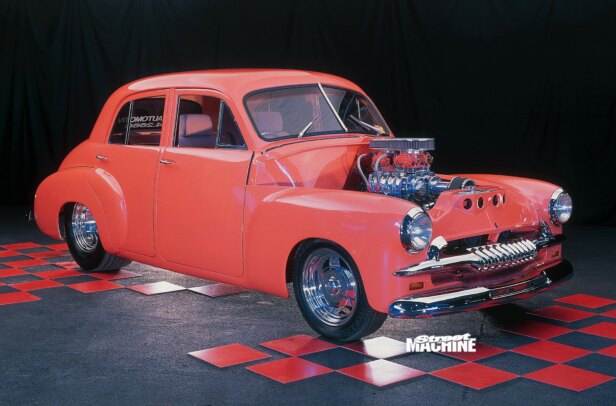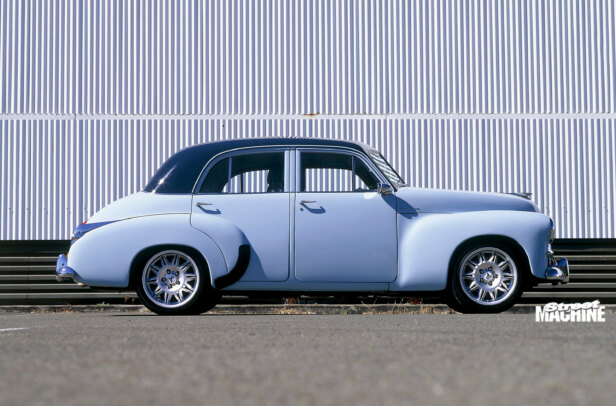Old school is the new cool. But for guys like father and son team Peter and Dean Woolley it’s never been any other way. It’s no surprise — tricked-out rice rockets don’t belong in the country back lots of Stawell, Vic. You need an Aussie icon like this immaculate 1956 FJ Holden Special. Simple, low-buck cool.
First published in the June 2006 issue of Street Machine

Semi-retired 68-year-old truck driver Peter had a dream to build a classic tribute to his well-spent youth.
“The goal was to build the car I could never afford when I was a young bloke.” He says. So the hunt began to find a suitable FJ sedan project to replace his ute. “I’ve had FJs all my life. When you’re onto a good thing, why change?”
An ad in the local rag turned up a likely candidate. Peter asked the seller how it was for rust.
“Not much,” she said, “but there is a small hole in the roof.”

Small hole? Try something big enough to shoot wildlife from! This FJ was a spotter’s car before being sidelined as a possible restoration. Peter and Dean gathered the bits and dragged the beast home. After the hole was filled with a section from a donor car they got on with all the usual stuff “although the bloody bower birds had helped themselves to a lot of the bright-work which really pissed me off — these bits are not easy to find ya know!”
The FJ was in good condition considering its past, with few items needing replacement. Even some of the rubbers are original!
“We were on a tight budget so only what needed fixing was fixed,” says Peter.

That doesn’t mean the car lacks any detail — the tinware this Humpy has hauled home is testament to that! What’s more amazing is that all the restoration work took place 15 years ago! Central Park Smash Repairs handled the bodywork and also applied the Bezel Grey top colour and the Dunno Grey lower paint. What shade is Dunno Grey? “It was a long time ago so I dunno!”
The main focus of the car has to be the old-school blown grey motor. Dean’s a machinist/fitter and is responsible for the art beneath the Humpy’s hood. Check the machined brass caps on the fluid reservoirs; every component not only has a function but has been carefully crafted. Nothing here is off the shelf from a parts shop.


M&W Engine Builders in Ballarat, Vic, was responsible for building the long engine. A 138 EJ Holden-based block was taken out to 143.5 cubes. The pistons are now 1/8-inch oversize from the standard three-inch units. Internals are mostly stock but all the important bits, like crank and conrods, have been polished. In keeping with what’s known to work well in hot grey motors, a Wade 101-grind cam bumps standard Holden red motor valves in the ported and polished grey head. One trick for the valve springs was the use of Holden outers and Vanguard (or Massey Ferguson tractor) inner springs!
Lighting the fire is an ingenious electronic ignition — an XE Falcon electronic distributor top grafted onto the grey motor dizzy bottom.

After the car had been on the road for about 10 years, Peter heard about a Norman supercharger for sale.
“I thought: ‘I gotta have me one of those!’” he says. After buying all the bits, Peter realised he was going to need some major help fitting it all — it’s good having a machinist for a son.
“Dad came home with a bunch of bits — a few carbs and a couple of damn ugly manifolds with an almost-shiny Model 70 Norman supercharger. ‘I wanna put this on!’ he said.”

Pointing to the dog’s breakfast manifolds — home-made RHS, a couple of copper bends, half a pound of bronze holding on a pair of carby flanges “that looked like they’d been cut out with a dull shark”, Dean insisted on making his own.
He custom fabricated a better flowing manifold from 14 individual pieces of aluminium, all TIG-welded together, which Dad polished.
This particular model of Norman blower is water-cooled which let Dean showcase his craftsmanship once more. Check how neatly the water pipes have been plumbed — it looks factory.

Twin 15/8-inch SU carbs receive fuel from an SU-type electric fuel pump and draw air from a hand-made aluminium induction box. Cold air comes in under and next to the grill-badge, along the inside of the bonnet skin and straight over the top of the air filter via some tubes Dean attached under the skin.
“I’m still cursing that airbox design. Yeah, it looks great but the only bloody air filters that fit are expensive Rover V8 jobbies at $38 each — and they make ya buy two of ’em!” curses Dean.
Dean also got inside the eccentric vane-type blower, which works rather like the vanes in an air tool. The blower springs on the internal vanes are new-old-stock Vietnam war teleprinter springs! Dean’s responsible for the water/methanol injection set-up plumbed into the blower which comes on at about 3lb of boost.

“The nature of a supercharger is that it’s only useful when you’ve got ya welly into it. The rest of the time it’s just using extra fuel to turn it ’round,” says Peter.
Fine, but how do you stop a blower turning on a running engine? A bit of internal modification and a nifty little spindle brake to stop it free-wheeling.
“I made a small pair of brake shoes which the guys at Lusky Automotive in Ballarat bonded some linings onto for me,” says Dean. This is synchronised with an electronically activated clutch from an a/c unit so when the clutch is disengaged, the spindle brake comes on. It’s not simple, but it’s effective.

“It’s a great way of pleasing the law as well — you just switch it off and say: ‘No officer,’ and you’re on your way!” Peter laughs.
Transferring the neddies is still down to the original three-speed column shift — with no synchro on first. Keeping it all cool is a fat-cored standard radiator and a thermo fan. Waste gases are hurried into a custom set of extractors and an old-school favourite, a twin two-inch system, for that classic grey growl.
All the mechanicals throughout this car are hopped-up originals, so the car retains the factory underpinnings, albeit breathed on by Dean and Peter.

“We stuck to what tricks we knew from days gone by — we have very little money and lots of time,” says Peter. This retro-recipe was adhered to throughout the car and there’s not one new item used which hasn’t been disguised as OEM or period.
Factory drum brakes do their utmost to pull up this heavy-breathing Humpy. Custom sheet-metal scoops direct air into the now ventilated (with a drill) backing plates. Do they work well?
“I call ’em hope brakes,” says Peter. “You hope like hell you’re gonna stop! Brakes are for tourists out here anyhow — you don’t drive like the devil unless you have the room.”


For the FJ, the right stance and the right wheels are all that’s needed for street cred. Lowering the car was simple — a little nicked out of the standard front coils while the rear springs were left stock. Pedders and Monroe shocks settle it.
Tramp rods were another home-made addition. “You’ve gotta have tramp rods to show the punters behind you that you mean business!” says Peter. Nothing but the best water pipe was used to fabricate them, again with top-notch craftmanship.
Rounding off the retro look are custom 14×6 painted steelies, made using FJ centres so the FJ hubcaps can be retained.

Of course, a car of this calibre has collected many dust collectors over the years and the guys keep refining different aspects of the car, so like all good projects it’s never really finished.
“Dean has bought me a Daimler convertible so that I won’t get bored. Frankly that project scares me. I know my FJs, so I think I’ll stick with them.”
STORMIN’ NORMAN
While most of us are familiar with the centrifugal and Roots-type blowers, the eccentric vane style — of which the Aussie-made Norman is a prime example — is less well-known. Besides the Norman, vane-style blowers were also made by a number of other manufacturers, including the American Judson brand, used on Ford side-valve V8s and VWs, and the English Shorrock, used on marques such as MG.

Howzit work? Well the rotor sits in an eccentric cylinder and there are spring-loaded vanes mounted vertically on this rotor. As the rotor turns, the air is forced into an ever-decreasing area via the sweeping action of the vanes and viola! you have compressed air. Air tools also employ a similar vane set-up to drive them.

PETER WOOLLEY
1956 FJ HOLDEN SPECIAL SEDAN
| Colour: | Bezel Grey over Dunno Grey |
| HOWLIN’ | |
| Engine: | 138 EJ grey bored to 143.5ci |
| Internals: | Polished stock crank and rods, braced main bearing caps, Wade 101-grind cam, solid lifters |
| Head: | Ported and polished, red motor valves, Vanguard springs |
| Distributor: | XE Ford electronic top half mated to grey motor bottom |
| Induction: | Twin 15/8in SU carbs, custom manifold and airbox |
| Blower: | Norman eccentric vane Model 70, water/methanol injection |
| Exhaust: | Custom extractors into two-inch twin system |
| Cooling: | Heavy-duty standard radiator, thermo fan |
| GROWLIN’ | |
| Tranny: | Standard three-on-the-tree manual |
| GLIDIN’ | |
| Wheels: | Custom 14×6 steelies with FJ centres |
| Tyres: | Round and black, 195/65 all ’round |
| Suspension: | Two-inch lowered stock coils (f), stock leaves, home-made tramp rods (r) |
| Shocks: | Pedders (f), Monroe coil-overs (r) |
| Brakes: | Original drums, fabricated air scoops (f), drilled backing plates (f&r) |
| LOUNGIN’ | |
| Seats: | Stock benches (f&r), re-trimmed by Stawell Antiques and Upholstery |
| Tiller: | Stock, with Nasco horn ring |
| Belts: | Retractable Ford (f), panic straps and taxi rail (r) |
| Sounds: | No-name under-dash radio cassette |
| Instruments: | Original, plus Smiths for the vitals |
THANKIN’
Each other, and RJ & RA Altmann Engineering (03 5358 2279) for letting us use their equipment



Comments